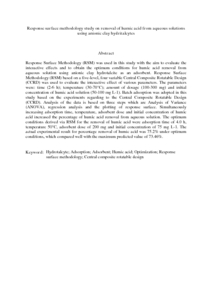Citation
Yasin, Yamin and Abdul Malek, Abdul Hafiz and Ahmad, Faujan
(2010)
Response surface methodology study on removal of humic acid from aqueous solutions using anionic clay hydritalcytes.
Journal of Applied Sciences, 10 (19).
pp. 2297-2303.
ISSN 1812-5654
Abstract
Response Surface Methodology (RSM) was used in this study with the aim to evaluate the interactive effects and to obtain the optimum conditions for humic acid removal from aqueous solution using anionic clay hydrotalcite as an adsorbent. Response Surface Methodology (RSM) based on a five-level, four variable Central Composite Rotatable Design (CCRD) was used to evaluate the interactive effect of various parameters. The parameters were: time (2-6 h); temperature (30-70°C); amount of dosage (100-300 mg) and initial concentration of humic acid solution (50-100 mg L-1). Batch adsorption was adopted in this study based on the experiments regarding to the Central Composite Rotatable Design (CCRD). Analysis of the data is based on three steps which are Analysis of Variance (ANOVA), regression analysis and the plotting of response surface. Simultaneously increasing adsorption time, temperature, adsorbent dose and initial concentration of humic acid increased the percentage of humic acid removal from aqueous solution. The optimum conditions derived via RSM for the removal of humic acid were adsorption time of 4.0 h, temperature 50°C, adsorbent dose of 200 mg and initial concentration of 75 mg L-1. The actual experimental result for percentage removal of humic acid was 75.2% under optimum conditions, which compared well with the maximum predicted value of 73.46%.
Download File
![[img]](http://psasir.upm.edu.my/16537/1.hassmallThumbnailVersion/Response%20surface%20methodology%20study%20on%20removal%20of%20humic%20acid%20from%20aqueous%20solutions%20using%20anionic%20clay%20hydritalcytes.pdf)  Preview |
|
PDF (Abstract)
Response surface methodology study on removal of humic acid from aqueous solutions using anionic clay hydritalcytes.pdf
Download (84kB)
| Preview
|
|
Additional Metadata
Actions (login required)
 |
View Item |

